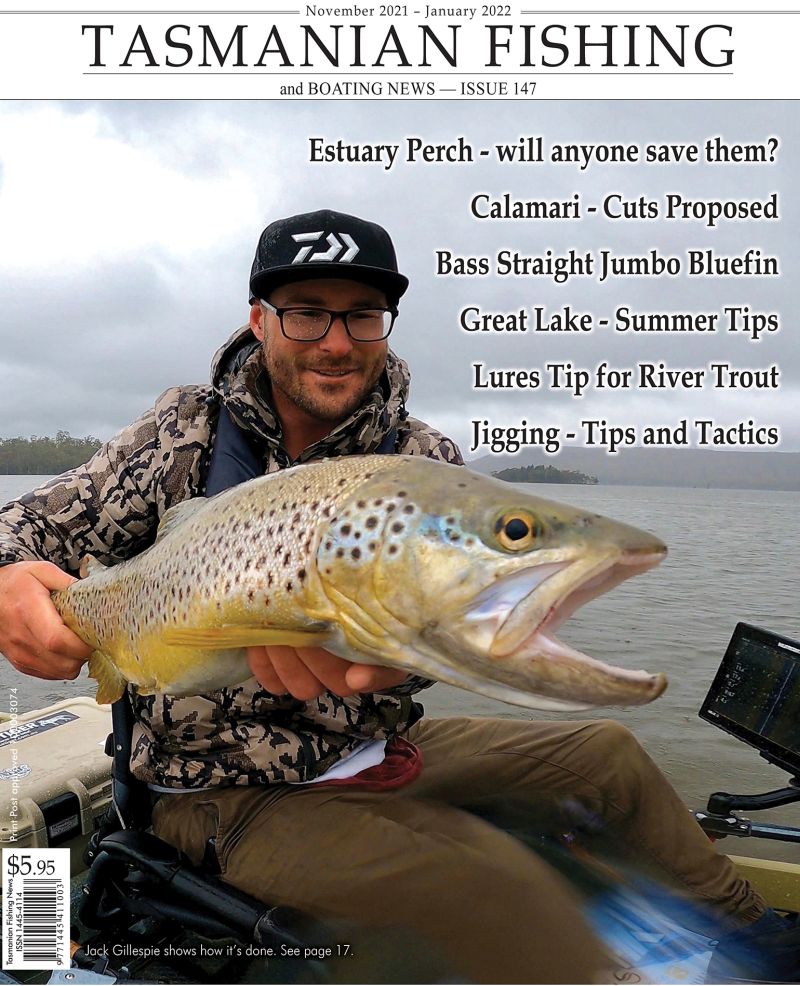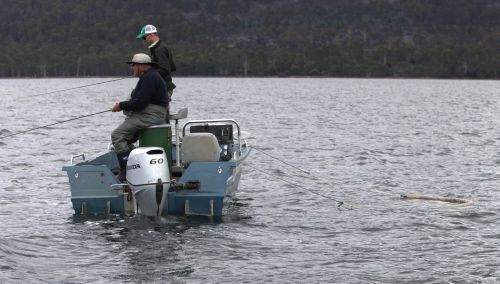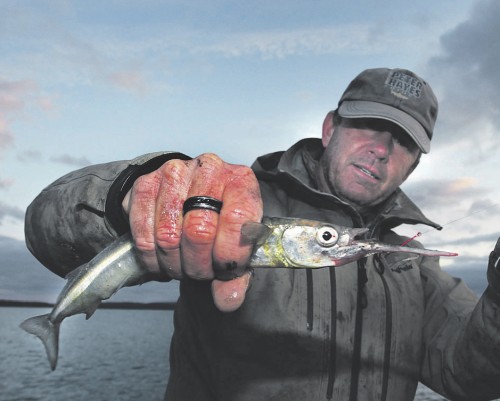 Presented from Issue 116, June 2015
Presented from Issue 116, June 2015
Cold weather can strike anytime in Tasmania and a lot of people complain about the cold constantly. Anglers are no different, but, like bush walkers it just means more appropriate clothes. And if there is a huge winter frost you know the day will be calm and bright and a joy to experience. So while it can be wild, cold, bitter and wet look out for approaching high pressure systems, plan a trip, and rejoice in the short calm winter days. The fishing can be grand.
Two inshore fish that are fun to catch over Winter are garfish and flounder. Both are pretty reliable fisheries, but preparation is the key. In fact it is the key to catching most fish.
With the latter fish in mind my good friend, Peter Hayes, had been watching the charts looking for a weather window to try a new water, unknown to either of us – Southport Lagoon. It is south of Southport with the turnoff past Hastings and the Ida Bay Railway. I had heard of it and it has always been a difficult place to access. Some recreational anglers accessed it from Southport by boat, waiting until the weather forecast was good and less than a metre of swell on the barway. That was not an option for us. We wanted to camp a few days and take a small boat and an off road camper. The road from Hastings is extremely rough, suitable for high clearance 4WDs and has potholes that need a GPS to navigate through. Soft-roaders and town all-wheel drives won’t cut it here.
Peter was the forward scout and had a couple of days with his children first before they had to leave, then I followed with Don - a man known to be very keen on hunting and gathering.
Measured kilometres from my home in Launceston it is near enough to 310 kilometres. A long way in Tasmania, but not in most places. However with a couple of stops for coffee, traffic in Hobart, numerous road works on the Midlands Highway and the very rough last six kilometres it took five hours. I am an unhurried driver, and there are few good things in life that happen quickly. When we arrived at Camp Southport Peter had a pretty satisfactory setup, boat in the water, fire going and gin and tonics dispensed. We sat and planned for a while and with a calm, cold night around us we gathered up our new SMD (surface mounted diode) flounder torches and headed into the dark around 11pm. We had great plans.
Southport Lagoon
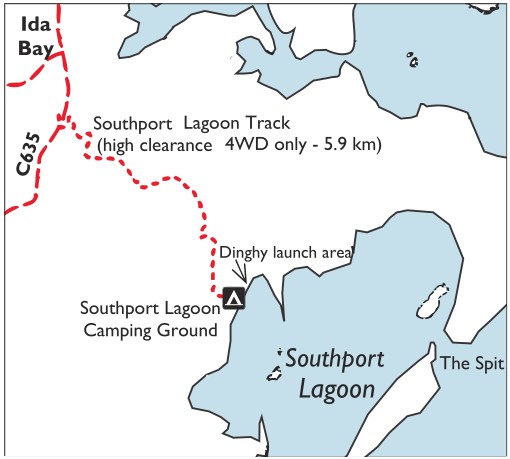
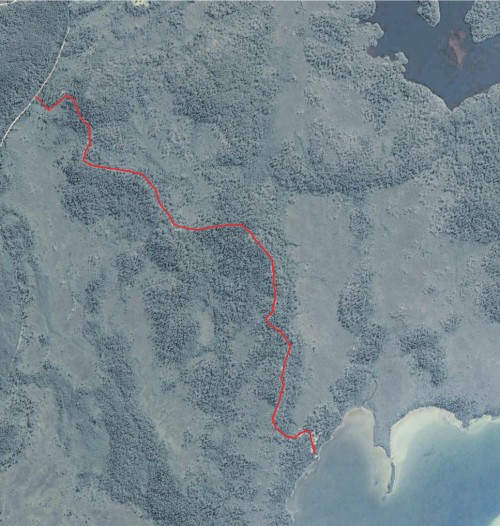
The Southport Lagoon Conservation area covers 4280 hectares with the lagoon covering 1060 hectares. It is one of the most pristine saltwater lagoons in southern Australia with very little impact over its entire catchment from humans. Most of it is less than one metre deep and it has extensive seagrass beds. It hosts the world’s smallest endangered seastar. Please value and care for it. Navigating the lagoon is interesting and you are encouraged to be aware of the marked channel and follow it. A speed limit of five knots applies and boats are limited to fourteen feet and 15hp, although much smaller boats will suffice.
We had a four metre boat and five horsepower motor. It was dark, cold and calm as we set off on our flounder, and hopefully, flounder mission. Peter had some success the previous night so we were confident. On the bow we also had an electric motor and when we arrived at the chosen shore this was deployed as our propulsion for the night.
This was to be a boat based exercise, unlike the ‘olden’ days when floundering meant a motorcycle battery towed around in a floating inner tube, connected to a sealed beam, that gradually lost its grunt. No, this was comfort floundering. Don was positioned on one side and me on the other with Peter on the electric motor. Pretty simple stuff this. Peter would motor us along and look for fish as we searched and scanned with the outstanding hi-tech lights. As peter was up higher we had a couple of different perspectives.
Once a flounder or flathead was spotted Peter would simply motor over to it and we would attempt to spear it. Sounds easy, and a number were. The flathead were a little harder, but over the evening we managed around 25. Not a lot, but a lot of fun. By the time we had a nightcap it was after 3am and bed was a delightful place. Don got up for a twinkle at dawn, but he was not heard nor acknowledged. ‘Should have seen the beautiful sunrise’ he told us later. We were hiding from the cold.
Day two was a late start and it was unknown whether we were having breakfast or lunch. It didn’t matter as there was no time frame, nor were we worried about tide or hordes of people – there were none.
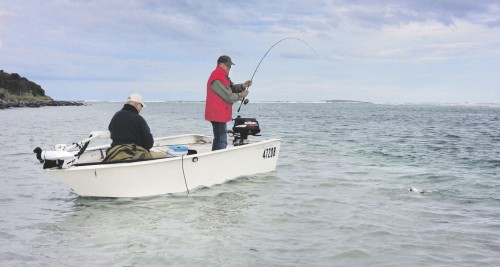 |
| Don Urquhart and Mike Stevens having a bit of fun with Australian salmon. Bled and eaten fresh they are great table fare. |
When we did get on the water early afternoon it was more discovery than fishing for a couple of hours and it is great to travel slowly and see how this lagoon is made up. The water is crystal clear and as mentioned earlier, mostly less than one metre deep. Some of it looks barren, but there are also extensive weed beds. The habitat is extraordinary. We had a few casts with plastics and Peter cast a fly. Don caught a flathead first cast, and then a few more. At some stage, after an hour or two, we continued our discovery mission and arrived at the mouth of the lagoon.
The tide was making and pouring into the lagoon – an ideal spot to find some Australian salmon, but after a couple of casts we noticed an intruder – a huge seal. Fifty metres away we could see Sammy tossing fish around – playing with it rather than eating, but by the size of him, or her, the smorgasbord had been long. Fish know danger – and they were avoiding this area, so we moved off and tried for some garfish.
Given we didn’t really know what the lagoon had to offer we just did what we would do elsewhere. For garfish we wanted some tidal flow, seagrass nearby, berley and patience. We had all that happening and twenty minutes later the garfish came up the berley trail. Peter was using his fly rod – with bait attached and out-fishing Don and I easily. We also caught some small salmon and kept a few for dinner that night.
So that part of the day ended with completing a tour around the rest of the lagoon and back to camp. We cooked garfish, flathead and salmon for tea and they were all outstanding. Whilst we all know how good flathead is – as is garfish, the salmon was just as good. It is a great table fish if bled, kept cold and consumed straight away. A lovely feast cooked by Peter. A couple of beers and a wine satisfied our thirst. We chatted about what time we would go back out for the flounder, but then there were some sprinkles of rain and some light, but annoying, wind gusts – something you don’t want when searching for flounder as the ruffled water cuts your vision enormously. So we sat and waited – yes, no, maybe?
Our contemplative mood was broken as we saw visions of a space craft coming towards our camp – powered by a four horsepower Yamaha. The water was glowing and moving – should we hide? What was it? We had seen some fishers earlier in the day motoring about – perhaps it was them, but what was the glow? Where they being chased by some luminescent underwater monster? Our interested was piqued. We had to see this – and were drawn to the light like suicidal moths. I could see the headlines now ‘Three anglers disappear without a trace from Southport Lagoon’.
Clunk, bang they arrived with the aura now surrounding their boat. They didn’t seem to care, so maybe there was no threat. Clunk, bang again – then ‘give us a hand mate’. We approached – to find the boat was surrounded by an aura of LED strip lights. These ran up both sides and across the front. This was an innovative way to fish for flounder I had not seen – hidden from all in a southern Tasmanian lagoon. This was masterful. We must know more. Shortly after boat two arrived – also surrounded by a southern lighting aura – sounds distinctly like Southern Aurora, but water based, not heavenly.
These innovative people should be on the television series Shark Tank. They had fixed LED strip lights to their boats under the waterline, shining brightly and revealing any flounder, flathead or other sub-marine within reach of their flounder spears. By the look of their haul, it was an impressive way to fish. Whilst well under their possession limits they had enough fish to last a week or two.
Also quite innovative was the side sponson extensions that had been added on to house batteries and extra gear. These added to stability as well and made great sense. This boat was designed for the job and was perfectly capable. With three people on board the operation goes something like this, I was told.
‘One person is on the tiller of the little 4hp motor and with lights switched on we simple motor along giving hand signals when we see a fish. There is no stopping or starting, and because the motor is a bit noisy only hand signals work. If we miss spearing one there is soon another. We find the flathead spooky and more difficult, but we get a few.’
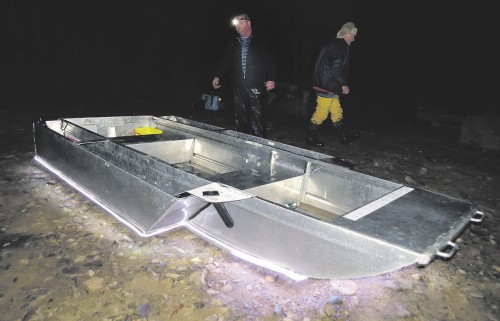 |
| Innovation and the modern technology of strip lights attached to the chines make this the ultimate flounder boat. |
The spears were three prong, but with the middle prong removed. The batteries, spears and all other paraphernalia was stored in the side sponsons, which kept the main floor area free. It a great arrangement. The little 4hp motor had an integral fuel tank so that helped keep the floor space free as well. Within a few minutes the boat could be setup – and conversely it was easily disassembled, put on the flat tray and on the way home. This was the ‘norm’ for them and whilst we have the latest rods, reels, flounder lights, Gortex, camper trailers, hi-tech head torches, boat loaders, electric motors etc., we could not compete. Back to basics we should go. ‘Twenty five bucks for a five metre strip’ we were told, referring to the LED light strips. I will be buying some to retrofit to my twelve footer, Peter wanted some and Don as well. The rain started and some breeze as well, so that ended our prospects of a night chasing flounder again. We felt quite inadequate and deflated now anyway, so perhaps it was best we didn’t try and compete with the local knowledge.
While all this was going on Don slept. He has missed the ‘light show’.
Camp visitor: The Crescent Honeyeater is found in a variety of habitats, from coastal heaths, wet sclerophyll forests to mountain forests. It is mostly found in damp gullies or in thick tea-tree scrub.
It feeds on nectar, fruit and insects, foraging mainly on understorey shrubs. It usually feeds singularly or in pairs, but may be seen feeding in small flocks.
The call is a loud, metallic, ‘egypt’. Not such a late start the next day, but again breakfast approached lunch, before we moved much. Peter wanted to stretch some flyline using his Spey/Switch rod and suggested we do a little video. Over to the mouth we motored, looking for some salmon. Sammy had gone and we were soon onto them every cast.
While we were shooting the video and Peter had to cut the barb off as he was catching salmon every cast. I am mightly impressed with Switch rods after Simon Gawesworth demonstrated them at the Australian Fly Fishing Museum earlier in the year. The ease with which anyone can learn to cast long distances effortlessly is astounding.
We caught up with some other locals that were there for the day and learned a little more about the lagoon. It is a place to treasure and take care of so your grand children can experience the way the world used to be.
The road is very rough and it is not a place to go often. Weather can be critical depending on the fishing you want to do. It would be a heavenly place to take your kayaks and spend a few days. Two staff from Parks and Wildlife came to do a tidy up and we had a chat. They cut back some encroaching shrubs from the designated camp spots and maintained the bio-toilets. The facilities include two double toilets and ten camp sites.
Take your own wood.
So if you want a winter break and see a good, slow moving high pressure system heading towards the south east of Tasmania keep Southport Lagoon in the memory bank.
Mike Stevens


